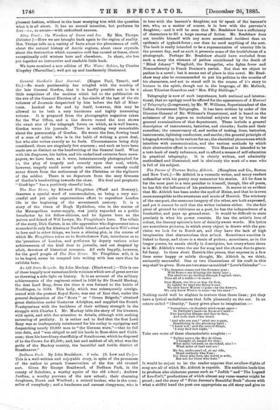Dedham Park. By John Bradshaw. 3 . vols. (S. Low and
Co.)— This is a well-written and enjoyable story, in spite of the proneness of the author to preach Conservatism of the fine old crusted sort. Given Sir George Braidwood, of Dedham Park, in the county of Saltshire, a worthy squire of the old school ; Andrew Jardine, a worthy parvenu of the new school ; their charming daughters, Norah and Winifred ; a retired banker, who is the coun- sellor of everybod'y ; and a handsome and earnest clergyman, who is
in love with the baronet's daughter, not to speak of the baronet's eon, who, as a matter of course, is in love with the parvenu's daughter,—and it will be seen that Mr. Bradshaw has a sufficiency of characters to fill a large canvas of fiction. Mr. Bradshaw does not trouble himself with any more sensational incident than an epidemic of typhoid-fever ; nor does he need anything of the sort. The book is really intended to be a representation of country life in the present day, and as such it presents some of the truthfulness of a photograph. Perhaps Mr. Bradshaw should have excluded from such a story the element of pathos contributed by the death of "Blind Johnny" Wingfield, the Evangelist, who fights fever and Nonconformity in Frank Denison's parish. Not that we object to pathos in a novel ; but it seems out of place in this novel. Mr. Brad- shaw may also be recommended to put his politica in the mouths of his characters, and not to stand still in the course of Vs story to lecture in the spirit, though not in the language, of Mr. Mallook, about Tiberius Graeohus and "Mrs. Fifty Shillings."
Telegraphy is now of such importance, both national and interna- tional, that no apology need be offered for the appearance of A Manual of Telegraphy (Longmans), by Mr. W. Williams, Superintendent of the Indian Government Telegraphs. It has been written by order of the Director-General of Mr. Williams's Department, and is based on the substance of the papers on technical subjects set by him at the general examinations of that department. These include a general description of instruments, batteries, and circuits ; faults and their remedies; the conservancy of, and modes of testing, lines, batteries, instruments, lightning conductors, and earths ; the general principle of telegraph working in its various for.ris; the electrical phenomena which interfere with communication, and the various methods by which their obstructive effect is overcome. This Manual is intended to be a text-book of ready reference, and to affords means of self-education in practical telegraphy. It is clearly written, and admirably methodised and illustrated, and is obviously the work of a man who is full of his subject.


































 Previous page
Previous page